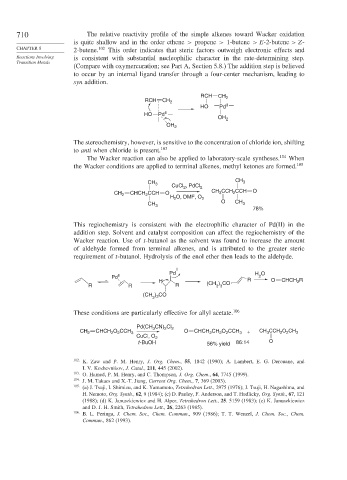Page 734 - Advanced Organic Chemistry Part B - Reactions & Synthesis
P. 734
710 The relative reactivity profile of the simple alkenes toward Wacker oxidation
is quite shallow and in the order ethene > propene > 1-butene >E-2-butene >Z-
CHAPTER 8 2-butene. 102 This order indicates that steric factors outweigh electronic effects and
Reactions Involving is consistent with substantial nucleophilic character in the rate-determining step.
Transition Metals
(Compare with oxymercuration; see Part A, Section 5.8.) The addition step is believed
to occur by an internal ligand transfer through a four-center mechanism, leading to
syn addition.
RCH CH 2
RCH CH 2
HO Pd II
HO Pd II
OH 2
OH 2
The stereochemistry, however, is sensitive to the concentration of chloride ion, shifting
to anti when chloride is present. 103
The Wacker reaction can also be applied to laboratory-scale syntheses. 104 When
the Wacker conditions are applied to terminal alkenes, methyl ketones are formed. 105
CH 3
CH 3
CuCl , PdCl 2
2
CH 2 CHCH CCH O CH CCH CCH O
2
3
2
H 2 O, DMF, O 2
O CH
CH 3 3
78%
This regiochemistry is consistent with the electrophilic character of Pd(II) in the
addition step. Solvent and catalyst composition can affect the regiochemistry of the
Wacker reaction. Use of t-butanol as the solvent was found to increase the amount
of aldehyde formed from terminal alkenes, and is attributed to the greater steric
requirement of t-butanol. Hydrolysis of the enol ether then leads to the aldehyde.
II
Pd H O
Pd II 2
H (CH ) CO R O CHCH 2 R
R R R 3 3
(CH ) CO
3 3
These conditions are particularly effective for allyl acetate. 106
Pd(CH CN) Cl 2
2
3
CHCH O CCH O CHCH CH O CCH CH CCH O CH
CH 2 2 2 3 2 2 2 3 + 3 2 2 3
CuCl, O 2
t -BuOH 56% yield 86:14 O
102 K. Zaw and P. M. Henry, J. Org. Chem., 55, 1842 (1990); A. Lambert, E. G. Derouane, and
I. V. Kozhevnikov, J. Catal., 211, 445 (2002).
103
O. Hamed, P. M. Henry, and C. Thompson, J. Org. Chem., 64, 7745 (1999).
104 J. M. Takacs and X.-T. Jiang, Current Org. Chem., 7, 369 (2003).
105 (a) J. Tsuji, I. Shimizu, and K. Yamamoto, Tetrahedron Lett., 2975 (1976); J. Tsuji, H. Nagashima, and
H. Nemoto, Org. Synth., 62, 9 (1984); (c) D. Pauley, F. Anderson, and T. Hudlicky, Org. Synth., 67, 121
(1988); (d) K. Januszkiewicz and H. Alper, Tetrahedron Lett., 25. 5159 (1983); (e) K. Januszkiewicz
and D. J. H. Smith, Tetrahedron Lett., 26, 2263 (1985).
106
B. L. Feringa, J. Chem. Soc., Chem. Commun., 909 (1986); T. T. Wenzel, J. Chem. Soc., Chem.
Commun., 862 (1993).

